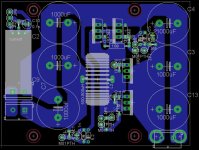bradleyk
10 mW
hey,
i looking at designing a 3kw motor controller for a bit of practice before i try at a 15kw continuous for a car.
from reading arlo's and zombies i will be using Lebowski's controller.
i have a bunch of these (ixth88n30p) lying around, i know these aren't the best and should probably get some better ones for the 20kw motor driver.
but for 10a they should be fine? the 40mOhm rds(on) is a bit high? should make the de-sat easier.
will be making the 6 fet 3kw from them as a test.
with TD350E as a driver (no boost stage)
from reading zombies thread, i shouldn't need the boost, [strike]for the larger version?[/strike]. changing to 300+ phase amps might.
for the 15kw, i am thinking 12 fet's should be good.
i am planning on designing the same controller board for both and the same drivers, hoping that any mistake i make on the 3kw can be fixed for the 20kw, with the 3 still working.
i will be using the 3kw for an AC so it probably doesn't need Lebowski's controller but might be good to practice with.
once i get the controller in the car working i will be looking at making a bike, with the same controller or higher power
i read the zombies has redesigned his driver to have no boost, i haven't found it, maybe he can post it. but i plan to have a look at learning kicad so i can edit. it is quite different then eagle.
thanks all
im an aussie by the way
i have designed a single 400v to 200v 10a cc cv power supply. using a bootstraped FAN7390 running at 31k synchronous . i haven't got around to finishing it, i think the coil is saturating at 8a, i discovered how to make that myself. could be quite bad. hopefully it was a step in the right direction.

it was non isolated. the plan was to design an isolated PFC.
Desat detection
i haven't played with de-sat before.
in theory for desat to trigger the voltage applied to the pin needs to be higher then the internal reference(7.2v nom)
for a 20a limit
7.2(ref) - 0.7(diode will need to adjust to spec.) - 0.25v(1k resistor @ 250ua) - 0.8(fet 40mOhm at 20a) = 5.45v zener @ 250ua
Mostfet gate resistor
i have no clue,
i know that it needs to be switched soft enough to reduce ringing and noise, and too slow and the fet overheats, if it turns on at all.
i have 2 rigol D1052E scopes, 30v 5a cv cc psu. always enjoy buy more
i looking at designing a 3kw motor controller for a bit of practice before i try at a 15kw continuous for a car.
from reading arlo's and zombies i will be using Lebowski's controller.
i have a bunch of these (ixth88n30p) lying around, i know these aren't the best and should probably get some better ones for the 20kw motor driver.
but for 10a they should be fine? the 40mOhm rds(on) is a bit high? should make the de-sat easier.
will be making the 6 fet 3kw from them as a test.
with TD350E as a driver (no boost stage)
from reading zombies thread, i shouldn't need the boost, [strike]for the larger version?[/strike]. changing to 300+ phase amps might.
for the 15kw, i am thinking 12 fet's should be good.
i am planning on designing the same controller board for both and the same drivers, hoping that any mistake i make on the 3kw can be fixed for the 20kw, with the 3 still working.
i will be using the 3kw for an AC so it probably doesn't need Lebowski's controller but might be good to practice with.
once i get the controller in the car working i will be looking at making a bike, with the same controller or higher power
i read the zombies has redesigned his driver to have no boost, i haven't found it, maybe he can post it. but i plan to have a look at learning kicad so i can edit. it is quite different then eagle.
thanks all
im an aussie by the way
i have designed a single 400v to 200v 10a cc cv power supply. using a bootstraped FAN7390 running at 31k synchronous . i haven't got around to finishing it, i think the coil is saturating at 8a, i discovered how to make that myself. could be quite bad. hopefully it was a step in the right direction.
it was non isolated. the plan was to design an isolated PFC.
Desat detection
i haven't played with de-sat before.
in theory for desat to trigger the voltage applied to the pin needs to be higher then the internal reference(7.2v nom)
for a 20a limit
7.2(ref) - 0.7(diode will need to adjust to spec.) - 0.25v(1k resistor @ 250ua) - 0.8(fet 40mOhm at 20a) = 5.45v zener @ 250ua
Mostfet gate resistor
i have no clue,
i know that it needs to be switched soft enough to reduce ringing and noise, and too slow and the fet overheats, if it turns on at all.
i have 2 rigol D1052E scopes, 30v 5a cv cc psu. always enjoy buy more


